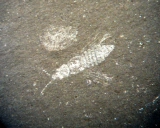 After finishing up at the Smithsonian, I made the short drive to Solomons, Maryland to visit the Calvert Marine Museum and their paleontology curator, Stephen Godfrey. Stephen and I have been planning to work on a particular project together for some time now, and it seems we’re finally getting around to doing the actual work.
After finishing up at the Smithsonian, I made the short drive to Solomons, Maryland to visit the Calvert Marine Museum and their paleontology curator, Stephen Godfrey. Stephen and I have been planning to work on a particular project together for some time now, and it seems we’re finally getting around to doing the actual work.
The project is on a subject near and dear to my heart, squalodont whales. Squalodonts were the first fossil whales I ever studied or prepared, and both my undergraduate thesis and my doctoral dissertation focused on this group.
The Calvert Marine Museum has a quite unusual squalodont, which was found in the Calvert Cliffs by Paul Murdoch (I think–someone correct me if I’m mistaken). Squalodon is one of the largest odontocetes in the Calvert Formation, but this specimen is pretty large even for Squalodon. Unfortunately the skull was shattered, so reconstructing it has been a difficult task. Our efforts on the rostrum are shown at the top, in ventral view.
There is quite a bit of additional material with this specimen, including several of the distinctive squalodont teeth:
 One of the interesting things about squalodonts is that they were one of the last groups of toothed whales to retain multiple distinct roots on their teeth; pretty much all contemporary and subsequent toothed whales have single-rooted teeth. Squalodonts also retained a strongly heterodont dentition, in that the anterior and posterior teeth were completely different shapes (the tooth above is a posterior tooth).
One of the interesting things about squalodonts is that they were one of the last groups of toothed whales to retain multiple distinct roots on their teeth; pretty much all contemporary and subsequent toothed whales have single-rooted teeth. Squalodonts also retained a strongly heterodont dentition, in that the anterior and posterior teeth were completely different shapes (the tooth above is a posterior tooth).
Stephen and I are going to try to make some progress on this specimen in the coming months, so you should be hearing more about it in the future.
***
Since I’ve been back at the museum I’ve been trying to catch up on paperwork, as this Thursday I’ll be leaving for Minneapolis to attend the Geological Society of America meeting. I’ll be blogging about geological sites both on the drive out and back, as well as reporting on the talks I attend at the conference.









